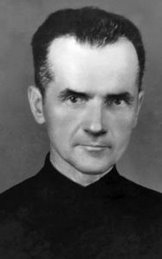The Endurance, stuck in the ice:

Endurance: Shackleton’s Incredible Journey
by Alfred Lansing
I first heard about Ernest Shackleton on William Bennett’s talk radio program when he read this famous quote about Shackleton:
"For scientific leadership, give me Scott, for swift and efficient travel give me Amundsen. But when you are in a hopeless situation, when you are seeing no way out, get down on your knees and pray for Shackleton. Incomparable in adversity, he was the miracle worker who would save your life against all the odds and long after your number was up. The greatest leader that ever came on God's earth, bar none."
- Sir Raymond Priestley, a member of the 1907-09 Nimrod Expedition.
I chose to read about Shackleton because the world needs heroes of every kind and in every land – especially in the Church – and any man who inspires such praise may teach one something. Shackleton failed to reach his goal; but in the process of getting his colleagues and himself back to safety, he overcame tremendous obstacles.
Summary:
On December 5, 1914, Sir Ernest Shackleton set off from a tiny island in the South Atlantic called South Georgia Island on an expedition to travel across the South Pole. His expedition consisted of two groups; one which headed from South America to the South Pole, and one which originated in New Zealand. Mr. Lansing’s book only covered the events that transpired on the group from South America, which included Shackleton.
The general plan was to sail as close as possible to the South Pole and then start heading over land and ice across Antarctica and meet up with the other team on the far side. On the way, the group would conduct scientific observations and collect specimens.
His plan went terribly wrong. Before the expedition could land on Antarctica, the ship was gradually surrounded by ice while sailing in a body of water known as the Wedell Sea. By January, 1915 it was held fast by a dense pack of ice. Over time the ice in the Wedell Sea would move in a Northwesterly direction, where it would eventually break apart into open water. Shackleton settled in to wait for the ice to eventually release the ship.
Shackleton's Route - note the dates:

Instead, the ship was slowly crushed by the ice as it exerted tremendous pressure against the ship. This process took several days, so most of the supplies were gotten off the ship before it was destroyed. One of the most important items retrieved from the ship were the lifeboats, which would be needed when the ice pack brought them to the open sea. The time between entrapment and abandoning ship was 9 months: January to October, 1915.
The expedition moved a couple of miles from the Endurance and set up camp. As the ice moved closer to the open water, the ice floes began to break apart. Eventually – in April, 1916 after being stuck in the ice for more than a year, Shackleton’s party had to abandon the ice and set sail for several islands which stretch toward the tip of South America. Consider that these men were sailing in lifeboats, with only basic navigational aids. This part of the trip was hard for the men, as they could not decide which island to land on.
They eventually land on Elephant Island – more than 800 miles from South Georgia Island, their starting point. That distance stretches across some of the roughest seas in the world, and the risk of losing men in the journey was too great to make it with all three boats. Shackleton decided to make the trip in one boat with a small crew, and send a rescue party for the men he would have to leave behind.
The Drake Passage, as the sea between South America and Antarctica is called, is part of a current of water that circles the Antarctic, keeping warmer water from reaching the frozen continent. This current, aptly name the Antarctic Circumpolar Current, has no land mass to slow it down, so it can be quite strong. This current, along with the prevailing West winds, make rounding Cape Horn challenging, and the inspiration for the saying, "Below 40 degrees, there is no law. Below 50 degrees, there is no God."
Launching the rowboat Caird for the 800 mile final leg. Surf's up!

Shackleton left Elephant Island on April 24, 1916, and spent the next two weeks sailing to South Georgia Island. They almost foundered several times; once a huge wave struck their boat nearly filling it with water. Landing on the west side of the island, Shackleton had to walk across the barren, mountainous island to reach the settlement on the other side.
After reaching safety, Shackleton hired a ship to rescue the group that was left on Elephant Island, an ordeal that took more than three months to accomplish.
Discussion
Shackleton’s adventure is a metaphor for real life: bad things happen, events spin out of control, we get sidelined, and we spend hours in self-doubt, not sure of our future and second-guessing our decisions. Challenges that seem impossible loom before us, and when they are defeated, they are replaced by even greater trials.
Large carnivorous animals sometimes try to bite us. This is a leopard seal - they attacked some of the explorers!

All of these things happen to everybody, not just Antarctic explorers. But just like the men in this book, we usually have to stand and face whatever trials come our way. How we deal with our trials will determine more than just the ‘end result’ of our lives. For example, Shackleton’s expedition was a complete failure until one considers that he led his whole group out of the Antarctic without losing one man.
It reminds me of a reading at Mass recently, from St. Paul’s letter to the Romans:
“Not only that, but we even boast of our afflictions,
knowing that affliction produces endurance,
and endurance, proven character,
and proven character, hope,
and hope does not disappoint,
because the love of God has been poured out into our hearts
through the Holy Spirit that has been given to us”
Romans 5:3-5
The trials we face today, even when we fail, can strengthen and prepare us for even more hardships that are sure to find us.
I would not say that Shackleton was a saint. In looking up information on him, I read some things about him that were not so admirable. In addition, the whole reason for his expedition is, in my opinion, was for earthly fame and fortune rather than for scientific advancement or the greater glory of God. But looking beyond his faults, and reading Alfred Lansing’s book, gives one a good example of fortitude and resourcefulness.
I recommend this book without reservation.
One question should still bother you about this review: what did they eat?

 More pictures to follow on July 1st.
More pictures to follow on July 1st.
































